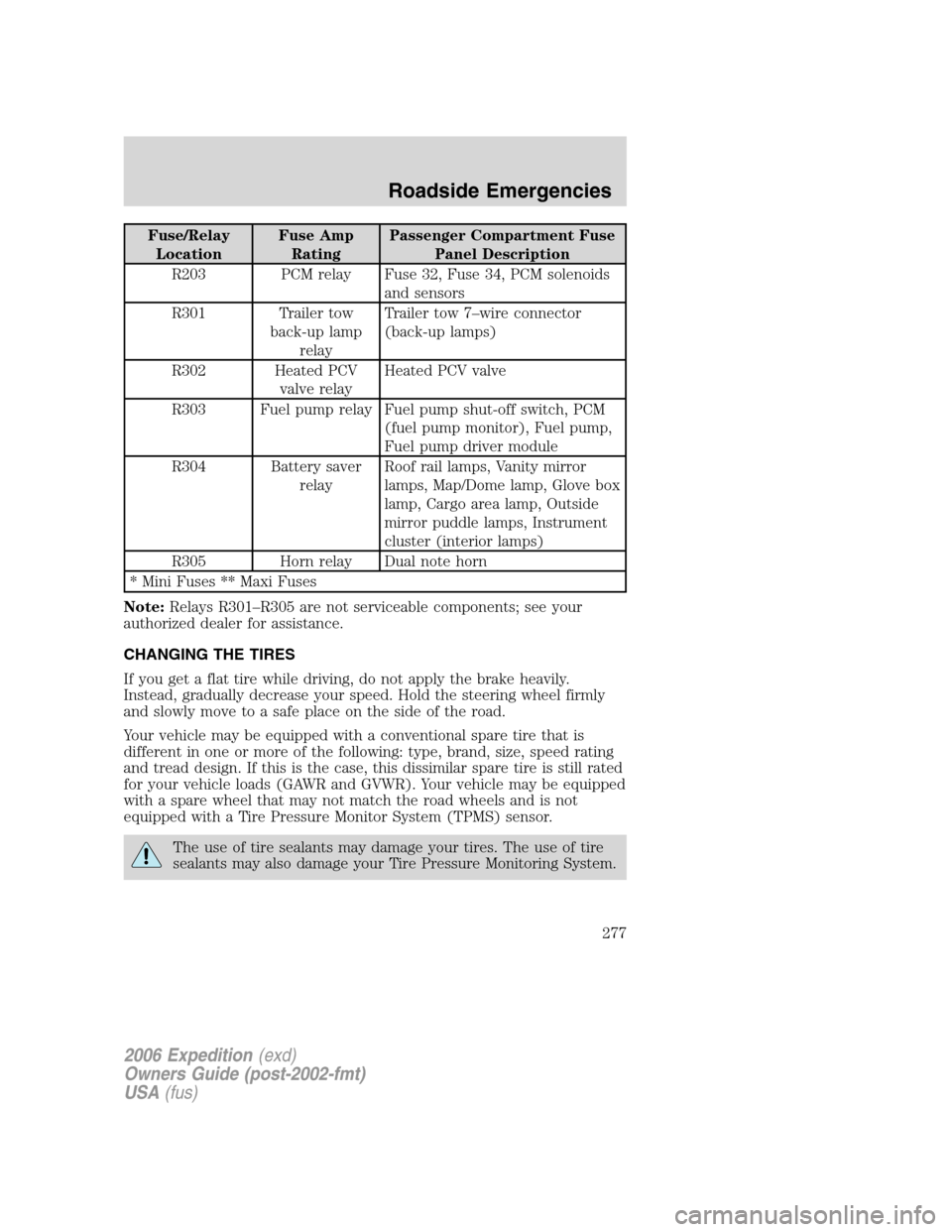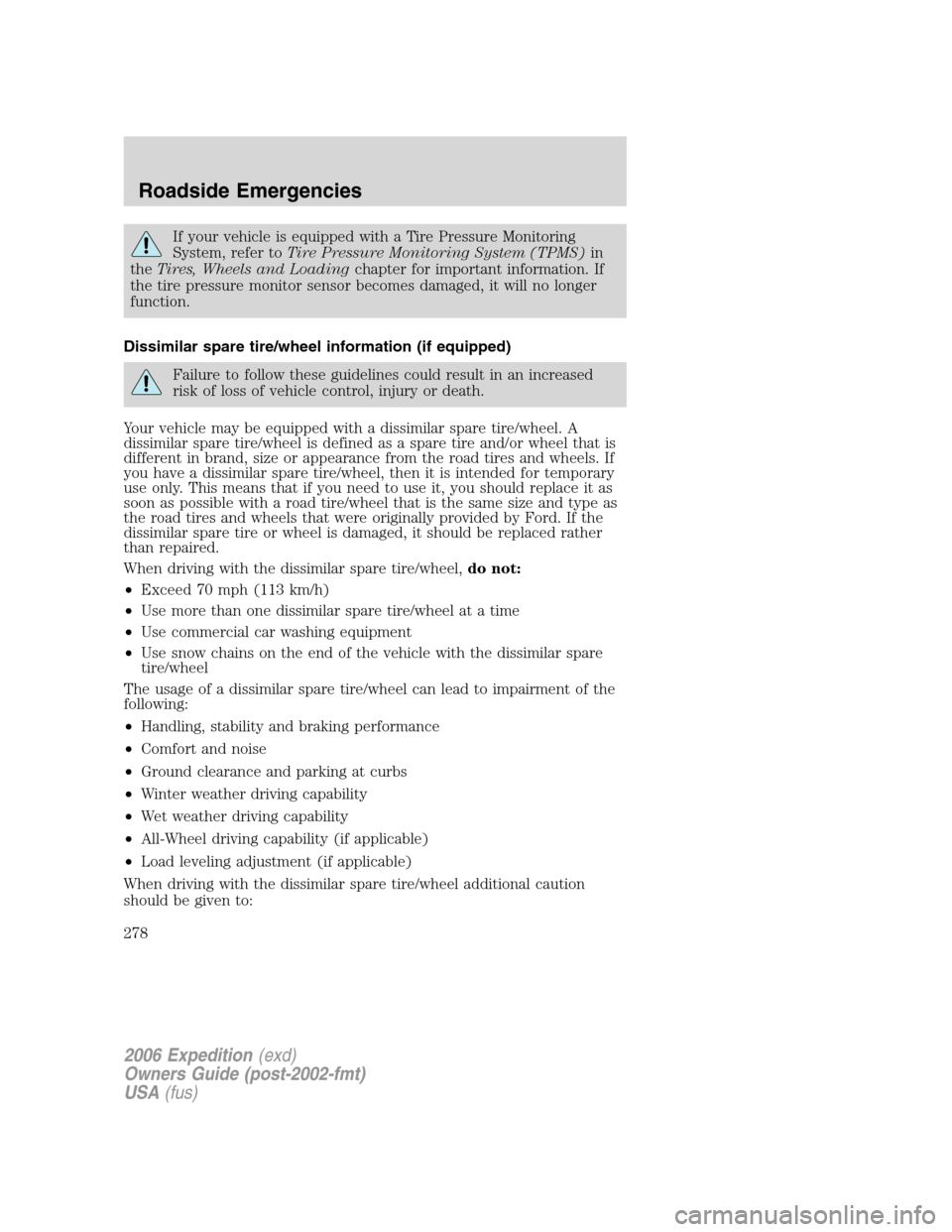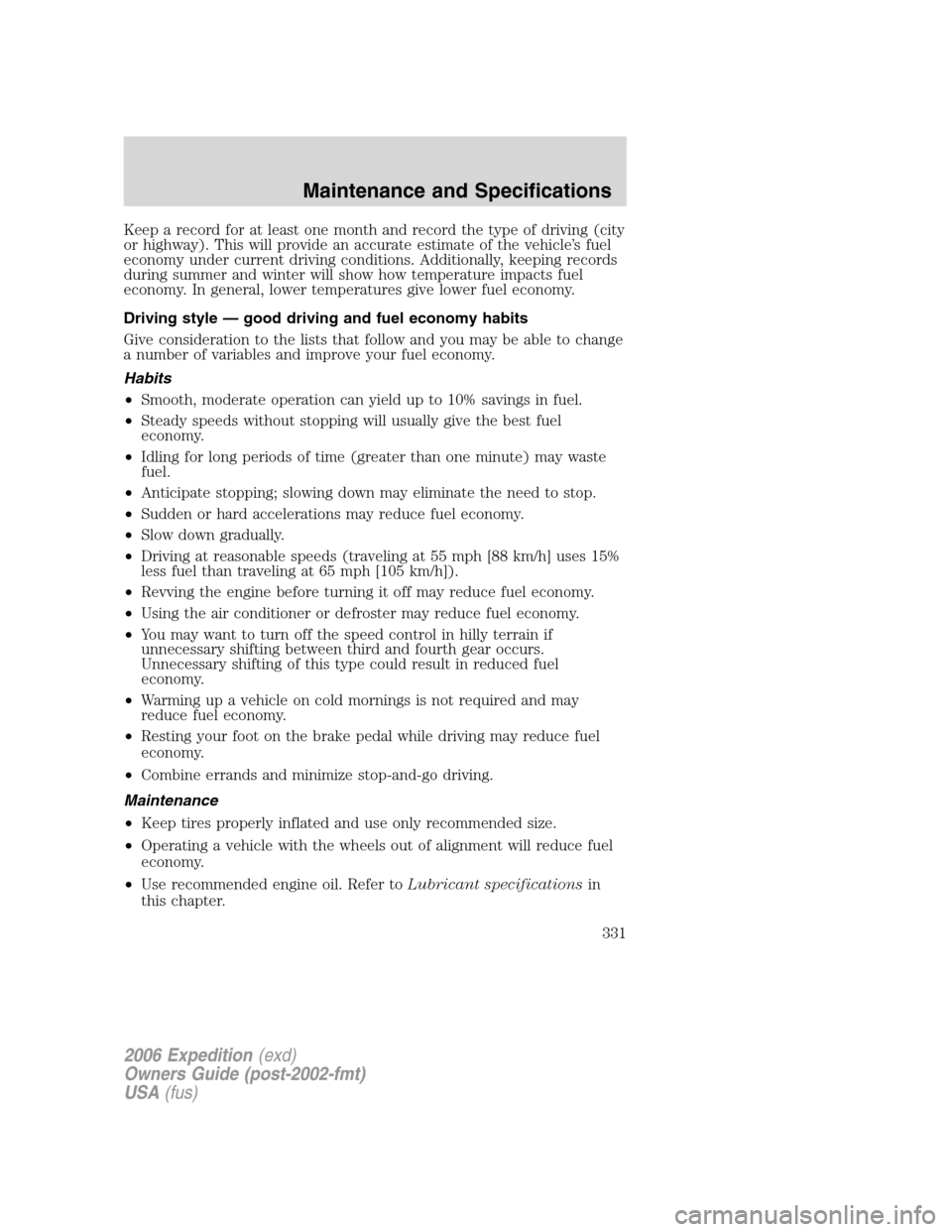Page 277 of 360

Fuse/Relay
LocationFuse Amp
RatingPassenger Compartment Fuse
Panel Description
R203 PCM relay Fuse 32, Fuse 34, PCM solenoids
and sensors
R301 Trailer tow
back-up lamp
relayTrailer tow 7–wire connector
(back-up lamps)
R302 Heated PCV
valve relayHeated PCV valve
R303 Fuel pump relay Fuel pump shut-off switch, PCM
(fuel pump monitor), Fuel pump,
Fuel pump driver module
R304 Battery saver
relayRoof rail lamps, Vanity mirror
lamps, Map/Dome lamp, Glove box
lamp, Cargo area lamp, Outside
mirror puddle lamps, Instrument
cluster (interior lamps)
R305 Horn relay Dual note horn
* Mini Fuses ** Maxi Fuses
Note:Relays R301–R305 are not serviceable components; see your
authorized dealer for assistance.
CHANGING THE TIRES
If you get a flat tire while driving, do not apply the brake heavily.
Instead, gradually decrease your speed. Hold the steering wheel firmly
and slowly move to a safe place on the side of the road.
Your vehicle may be equipped with a conventional spare tire that is
different in one or more of the following: type, brand, size, speed rating
and tread design. If this is the case, this dissimilar spare tire is still rated
for your vehicle loads (GAWR and GVWR). Your vehicle may be equipped
with a spare wheel that may not match the road wheels and is not
equipped with a Tire Pressure Monitor System (TPMS) sensor.
The use of tire sealants may damage your tires. The use of tire
sealants may also damage your Tire Pressure Monitoring System.
2006 Expedition(exd)
Owners Guide (post-2002-fmt)
USA(fus)
Roadside Emergencies
277
Page 278 of 360

If your vehicle is equipped with a Tire Pressure Monitoring
System, refer toTire Pressure Monitoring System (TPMS)in
theTires, Wheels and Loadingchapter for important information. If
the tire pressure monitor sensor becomes damaged, it will no longer
function.
Dissimilar spare tire/wheel information (if equipped)
Failure to follow these guidelines could result in an increased
risk of loss of vehicle control, injury or death.
Your vehicle may be equipped with a dissimilar spare tire/wheel. A
dissimilar spare tire/wheel is defined as a spare tire and/or wheel that is
different in brand, size or appearance from the road tires and wheels. If
you have a dissimilar spare tire/wheel, then it is intended for temporary
use only. This means that if you need to use it, you should replace it as
soon as possible with a road tire/wheel that is the same size and type as
the road tires and wheels that were originally provided by Ford. If the
dissimilar spare tire or wheel is damaged, it should be replaced rather
than repaired.
When driving with the dissimilar spare tire/wheel,do not:
•Exceed 70 mph (113 km/h)
•Use more than one dissimilar spare tire/wheel at a time
•Use commercial car washing equipment
•Use snow chains on the end of the vehicle with the dissimilar spare
tire/wheel
The usage of a dissimilar spare tire/wheel can lead to impairment of the
following:
•Handling, stability and braking performance
•Comfort and noise
•Ground clearance and parking at curbs
•Winter weather driving capability
•Wet weather driving capability
•All-Wheel driving capability (if applicable)
•Load leveling adjustment (if applicable)
When driving with the dissimilar spare tire/wheel additional caution
should be given to:
2006 Expedition(exd)
Owners Guide (post-2002-fmt)
USA(fus)
Roadside Emergencies
278
Page 331 of 360

Keep a record for at least one month and record the type of driving (city
or highway). This will provide an accurate estimate of the vehicle’s fuel
economy under current driving conditions. Additionally, keeping records
during summer and winter will show how temperature impacts fuel
economy. In general, lower temperatures give lower fuel economy.
Driving style — good driving and fuel economy habits
Give consideration to the lists that follow and you may be able to change
a number of variables and improve your fuel economy.
Habits
•Smooth, moderate operation can yield up to 10% savings in fuel.
•Steady speeds without stopping will usually give the best fuel
economy.
•Idling for long periods of time (greater than one minute) may waste
fuel.
•Anticipate stopping; slowing down may eliminate the need to stop.
•Sudden or hard accelerations may reduce fuel economy.
•Slow down gradually.
•Driving at reasonable speeds (traveling at 55 mph [88 km/h] uses 15%
less fuel than traveling at 65 mph [105 km/h]).
•Revving the engine before turning it off may reduce fuel economy.
•Using the air conditioner or defroster may reduce fuel economy.
•You may want to turn off the speed control in hilly terrain if
unnecessary shifting between third and fourth gear occurs.
Unnecessary shifting of this type could result in reduced fuel
economy.
•Warming up a vehicle on cold mornings is not required and may
reduce fuel economy.
•Resting your foot on the brake pedal while driving may reduce fuel
economy.
•Combine errands and minimize stop-and-go driving.
Maintenance
•Keep tires properly inflated and use only recommended size.
•Operating a vehicle with the wheels out of alignment will reduce fuel
economy.
•Use recommended engine oil. Refer toLubricant specificationsin
this chapter.
2006 Expedition(exd)
Owners Guide (post-2002-fmt)
USA(fus)
Maintenance and Specifications
331
Page 357 of 360

Pedals (see Power adjustable
foot pedals) ...............................114
Power adjustable foot pedals ...114
Power distribution box
(see Fuses) ...............................269
Power door locks ......................138
Power mirrors ...........................112
Power point ...............................108
Power steering ..........................244
fluid, checking and adding ....335
fluid, refill capacity ................340
fluid, specifications .........343, 345
Power Windows .........................111
Preparing to drive
your vehicle ...............................247
R
Radio ......................................19, 24
Rear window defroster ...............92
Relays ........................................268
Remote entry system .......139, 141
illuminated entry ....................144
locking/unlocking doors .........140
opening the trunk ...................140
panic alarm .............................141
replacement/additional
transmitters .............................143
Reverse sensing system ...........252
Roadside assistance ..................265
S
Safety Belt Maintenance ..........175
Safety belts
(see Safety restraints) ............166,
169–170, 172–173, 175Safety Canopy ...........................184
Safety defects, reporting ..........300
Safety restraints .......................166,
169–170, 172–175
belt minder .............................176
extension assembly ................175
for adults .................170, 172–173
for children .....................187–188
lap belt ....................................171
safety belt maintenance .........175
warning light and chime ........176
Safety seats for children ..........191
Safety Compliance
Certification Label ....................347
Seat belts
(see Safety restraints) .............166
Seats ..........................................151
child safety seats ....................191
cleaning ...................................305
memory seat ...................141, 155
SecuriLock passive
anti-theft system ...............147–149
Servicing your vehicle ..............308
Setting the clock
AM/FM/In-dash 6 CD ................26
Snowplowing .................................8
Spare tire
(see Changing the Tire) ...........279
Spark plugs,
specifications .............339, 345–346
Special notice
utility-type vehicles ....................8
Specification chart,
lubricants ...........................343, 345
Speed control ............................114
Starting your vehicle ........235–237
jump starting ..........................285
2006 Expedition(exd)
Owners Guide (post-2002-fmt)
USA(fus)
Index
357
Page:
< prev 1-8 9-16 17-24